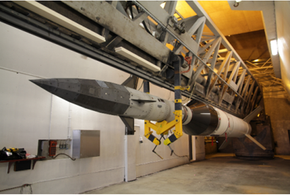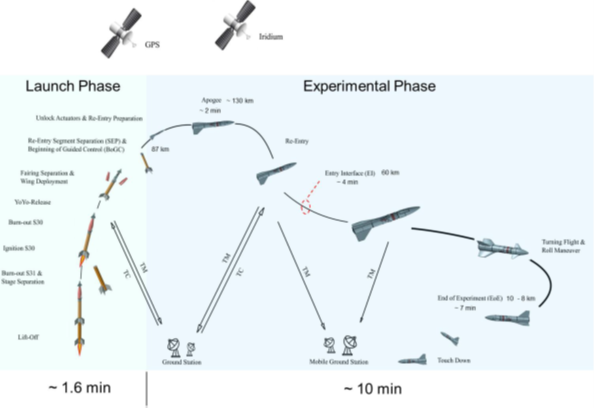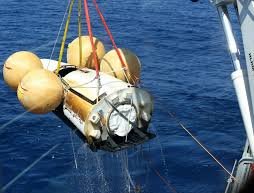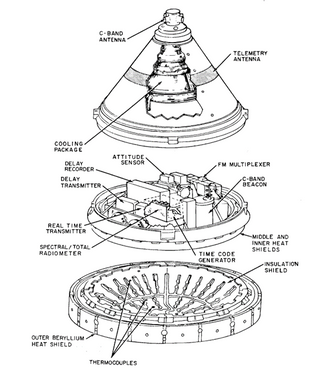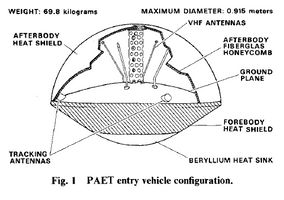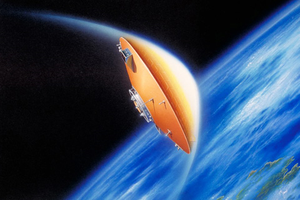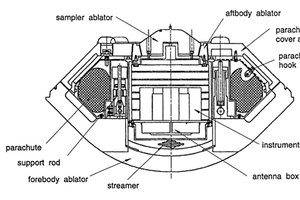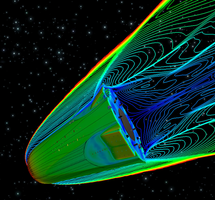Entry test missions
Not only the parachute systems require testing, but some missions are also launched just to validate the performance of a thermal protection system. An overview of these missions can be found here.
Some missions are flown to validate thermal and re-entry models and validate thermal protection in flight. These can be found here:
Click here for a more detailed page on missions that specifically aided in the development of space planes:
Deployable thermal protection systems are sometimes considered to be the future of EDL systems. They can significantly increase their size during entry, slowing the vehicle down significantly.
A significant part of the entry demonstrator missions were aimed towards the development of ballistic missiles for the military. Even Though military missions are not the primary focus of this website, it is impossible to ignore these developments when it comes to re-entry missions.
Not only were ballistic missiles of significant focus, but steerable entry vehicles were also researched. These moved to avoid incoming anti-air systems.
HEARTED
Operator: ESA
Mission: Re-Entry demonstrator
Flight: 2026
Status: Planned
Testing for:
HEARTED or The Hyper-velocity EArth Re-entry TEchnology Demonstrator Mission of ESA Re-entry is one of the most challenging phases of any space mission, especially when the vehicle has to withstand very high speeds and temperatures. The European Space Agency (ESA) is developing a new technology demonstrator, called HEARTED, to test and validate critical re-entry technologies for future missions.
HEARTED stands for Hyper-velocity EArth Re-entry TEchnology Demonstrator. It is a project that aims to fill the knowledge gap that Europe has in the field of high-speed re-entry, which is required for missions such as Mars Sample Return, Phobos Sample Return, or Polar Lunar Sample Return. HEARTED is a small capsule, about 1 meter in diameter and 80 kg in mass, that will be launched by a Vega-C rocket into a highly elliptical orbit around Earth. The capsule will then perform a controlled re-entry at a speed of about 13 km/s, which is much higher than the typical 8 km/s of a Low Earth Orbit (LEO) re-entry. The capsule will be equipped with several sensors and instruments to measure the aerodynamic, thermal, and structural loads during the re-entry, as well as the performance of the guidance, navigation, and control system. The capsule will also carry a thermal protection system (TPS) made of advanced materials that can withstand the extreme heat and pressure generated by atmospheric friction. The capsule will land with a parachute system in a remote area, where it will be recovered and analyzed. The data collected by the capsule will be used to validate and improve the design tools and methodologies for future re-entry missions.
HEARTED is important for several reasons. First, it will demonstrate the feasibility and reliability of a European high-speed re-entry system, which is essential for enabling ambitious exploration missions that involve returning samples or payloads from other planets or moons. Second, it will provide valuable data and experience on the aerothermodynamics of re-entry, which is the study of how the air flows around and interacts with the vehicle during its descent. This is a complex phenomenon that involves real-gas effects, shock waves, turbulence, plasma formation, radiation, and chemical reactions. These effects are difficult to predict and simulate with current models and tools, so they require experimental validation. Third, it will test the performance of new TPS materials and structures that can cope with the severe thermo-mechanical environment of re-entry. These include ceramic matrix composites (CMCs), ablative materials, crushable structures, seals, gaps, steps, and singularities. These elements are critical for ensuring the integrity and safety of the vehicle and its payload. Fourth, it will evaluate the performance of the guidance, navigation, and control system that will steer the capsule during its flight. This system will use a combination of flaps and thrusters to adjust the attitude and trajectory of the capsule according to a pre-defined flight profile. The system will also use an inertial measurement unit (IMU) coupled with a GPS receiver for navigation.
Render of HEARTED
Currently in its feasibility study phase (phase A), which started in 2020 and will end in 2022. This phase involves defining the mission requirements, designing the capsule configuration, selecting the TPS materials and structures, developing the flight software and hardware, performing numerical simulations and ground tests, and preparing the launch campaign. The next phase (Phase B) will start in 2023 and will last until 2025. This phase will involve finalizing the design of the capsule, manufacturing and assembling its components, performing qualification tests, integrating it with the launcher adapter, and delivering it to the launch site. The launch of HEARTED is planned for 2026 from Kourou, French Guiana. The mission duration will be about 100 minutes from liftoff to landing. The landing site will be located in an uninhabited area in Australia or Kazakhstan. [188, 189, 190]
SHEFEX
Operator: DLR
Mission: Re-Entry demonstrator
Flight: 2005, 2012
Status: Completed, third flight planned
Testing for:
The Shefex (Sharp Edge Flight EXperiment) program by the German Aerospace Center (DLR) involved a series of experimental spaceplanes to test technologies for future reusable space vehicles. The mission arose to address the problem of the space shuttle's 25,000 differently shaped tiles, which created high production and maintenance costs.
Within the Shefex flight test program, DLR focused on the development of re-entry and hypersonic technology. Using adapted sounding rocket systems, it was possible to perform cost-effective flight tests quickly. Comparing real flight data with simulations and ground tests helped verify tools and ground test results.
The first Shefex mission launched in 2005 on a Brazilian VSB-30 rocket, reaching over 200 km altitude before splashing down. It tested an unconventional faceted ceramic thermal protection system for 20 seconds at Mach 6.
Shefex II launched in 2012 on a Brazilian VS-40 rocket, reaching 250 km altitude and Mach 10-11 speeds for 45 seconds. It tested an updated faceted ceramic TPS and manoeuvrable reentry.
Shefex III was aimed to reach Mach 20 for 15 minutes, but this required a larger rocket that is not yet available. Further Shefex development is using other international flight opportunities.
A key goal was verifying faceted fiber ceramic TPS, sharp-cooled and uncooled leading edges to reduce future TPS costs by up to 70%. Contour-stable ablative leading edges, thermally stable fin structures, and lightweight fairings were also tested.
The rocket provided around Mach 5.6 velocity for 30 seconds during re-entry from 90 km to 20 km altitude. Flow effects and thermal loads were studied, with ablative coatings protecting fins and leading edges.
SHEFEX II pre launch
Shefex tested a facetted TPS concept with CMC panels made using liquid silicon infiltration. The flight aimed to validate analytical predictions and ground tests, acquiring data on sharp leading edges and seals. The recovery system included heat shield ejection and a high velocity drogue parachute.
ReFEx
Operator: DLR
Mission: Re-Entry demonstrator
Flight: 2024
Status: Planned
Testing for:
After completing SHEFEX I and II, DLR used the information gathered during these projects for the next step. This step was to perform a test flight with a winged vehicle which should resemble a possible winged first stage of a reusable launch vehicle. This is the reusable flight experiment ReFEX. Its goals are to gain operational experience with winged first stages and, more generally, to gather flight and design data [142].
The ReFEX vehicle will be around 450 kg in mass, of which the structure of the vehicle itself takes up more than half. The rest comprises the GNS system for autonomous flight, the fins and the avionics. It has a cylindrical body with a length of 2.7 m. It has two canards and a small delta wing at the back with a wing span of 1.1 m. As the ReFEX will be launched on top of a VSB-30, not inside a fairing, its non-symmetrical shape poses an issue, as it has a tail wing. Therefore, ReFEX will be partially hidden during the ascent by an external fairing structure. This structure covers the two folded wings and adds a find on only the fairing to make the vehicle symmetrical [142,144,145]. Although initially planned to have a parachute to cover the last part of the flight due to volume constraints, it was chosen to remove it and have the data continuously downloaded from the vehicle [142].
ReFEX is currently planned to be launched in 2024 in Australia. When it does and is separated from the VSB-30 rocket, it will start to descend. Part of the goal of gaining operational experience for winged stages is to test the autonomous GNC system and perform certain manoeuvres with the vehicle [142]. ReFEX will first make sure that it is belly-up when going into its hypersonic phase of the flight. This unusual orientation is due to stability reasons, as the tail fin would have no control when in the “normal” belly-down orientation [142]. Once ReFEX reaches Mach 1.5, it will rotate to a belly-down configuration, during which time it will also perform a turning manoeuvre. The end of the experiment is set at 8-10 km, after which ReFEX will perform a hard horizontal landing because it has neither a parachute nor landing gear for a soft landing.
IXV
Operator: ESA
Mission: Re-Entry demonstrator
Flight: 11-02-2015
Status: Succesfull
Testing for: Testing for Space Rider
Render of IXV attached to Vega
Upon re-entry, IXV performed a controlled descent and deceleration down to 26 km and Mach 1.45. As the main focus of the mission was proving the lifting body, the recovery system mostly consisted of off-the-shelf components. First, a pyrotechnic mortar deployed the pilot chute, a 1.7 m Disk-Gap-Band developed for NASA’s Mars missions. This pilot chute deployed a 4.3 m drogue parachute taken from the F-117 Nighthawk, slowing the vehicle down to Mach 0.3. At an altitude of 10 km, the first stage main parachute was deployed, a 7.4 m ribbon parachute also used on the F-111 Aardvark’s crew ejection capsule. Finally, at an altitude of 5 km and a speed of Mach 0.12, the second stage main parachute was deployed, a 29.6 m ringsail designed for the Curiosity rover’s landing on Mars. This parachute was initially reefed to 10%, fully inflating after 10 seconds to slow the vehicle down to its splashdown velocity of 6 m/s [151]. After splashdown, four large, 0.8 m3 airbags were inflated to provide flotation and stability to the vehicle before it could be recovered by the Italian ship Nos Aries [149] [151].
IXV post landing
IXV (Intermediate eXperimental Vehicle) was an intermediate step in the development programme for an autonomous European space transportation system. The programme started in 2002 as a follow-on of ARD (Atmospheric Reentry Demonstrator), a re-entry capsule that was launched atop an Ariane 5 in 1998 [149]. Rather than a blunt body type re-entry capsule like ARD, IXV was a lifting body type vehicle. This means that the shape of its fuselage generated lift without requiring wings, making it simpler than a winged vehicle like the Space Shuttle but more controllable than a blunt body re-entry vehicle like ARD or most crewed re-entry capsules. IXV performed a single suborbital test flight in 2015 on a Vega rocket and was the first lifting body to demonstrate re-entry under conditions representative of re-entry from Low Earth Orbit [149] [150]. The IXV programme has since been moved into the Space Rider programme, which aims to become Europe’s reusable space transportation system [150].
X-17
Operator: USAF
Mission: Flight testing re-entry vehicle geometries
Flight: may 1955 to march 1957
Status: Completed
Testing for:
The challenges associated with the survival of an object during reentry are many and particularly difficult to replicate in a laboratory environment. In the early ‘50s, scientists and engineers in the United States had attempted to create representative reentry environments by using shock-type wind tunnels or rocket engine exhausts to achieve a high heat flux to sub-scale test samples.
However, there was a need to test full-scale reentry vehicles at hypersonic speeds for complete validation of the new heat shield materials and reentry vehicle shapes. Because the Atlas and Titan vehicles were not yet flight-ready at the time, a new rocket was designed for atmospheric reentry vehicle flight testing: the X-17. The rocket was relatively small, allowing only for relatively lightweight payloads compared to later launch vehicles, however its contribution to the development of ablative materials and reentry vehicle shapes was invaluable in the late ‘50s. [191,192]
Onboard the X-17 vehicle, many differently shaped quarter-scale, half-scale, and full-scale reentry vehicles were flown on ballistic trajectories up to speeds of Mach 15. A total of 36 flight tests were performed between May 1955 and March 1957, of which only two resulted in a failure. These vehicles were never intended to be recovered and would often disintegrate at lower altitudes after the scientific data was transmitted to ground stations. [191,192]
The X-17 allowed scientists to gather in-flight data from differently shaped reentry vehicles and also test out multiple heat shield materials. After the success of the first phase of test flights, the X-17 rocket was used by the US Navy for their Polaris Flight Test Program (FTV).
Launch of an X-17
ARD
Operator: ESA
Mission: Re-Entry demonstrator
Flight: 21-11-1998
Status: Succesful
Testing for: Partially for European Crewed Transport Vehicle
The ESA Atmospheric Reentry Demonstrator or ARD was flown in the interstage of the third Ariane 5 rocket. The objective was to demonstrate the ability of ESA to perform a controlled atmospheric re-entry. The capsule was a scale model of the Apollo-style capsule and flew to an apogee of 830km. During the flight, the heat shield reached a temperature of about 900 deg C. The capsule performed multiple manoeuvres during entry demonstrating the ability of ESA to safely return a capsule through the atmosphere. The capsule was equipped with a parachute system for a safe landing. The drogue parachute had a diameter of 5.8 meters. The drogue was followed by a cluster of three 22.9 meter diameter main parachutes. To ensure the capsule remained afloat two balloons were attached and inflated during landing.
Render of ARD
FIRE
Operator: NASA
Mission: Re-Entry demonstrator
Flight: 1964 and 1965
Status: Succesful
Testing for: Apollo
Scematics of FIRE
As no human-rated spacecraft had re-entered at speeds corresponding to those Apollo would encounter during its return from the Moon, NASA decided to investigate this re-entry and not rely on the current data available and extrapolate this to the required re-entry conditions [161,162]. This was named project FIRE (Flight Investigation Re-entry Environment). Its objective was to gather data on convective and radiative heating, radio attenuation and material behaviour during a re-entry similar to a return trajectory from the Moon [163,164].
To accomplish these velocities, without actually having to fly a spacecraft to the Moon and back, project FIRE would be launched on an Atlas-D into a ballistic trajectory. However, the power of the Atlas launcher would not be enough to reach the required velocity of 11.3 km/s during re-entry [163,164]. So to achieve the needed velocity, an Antares II solid rocket motor was to accompany the re-entry capsule to, right before re-entry, give the final boost.
After separation from the Antares II solid rocket motor, the 85 kg Project FIRE capsules would speed towards the ground at 11.3 km/s when at 12.2 km above the ground. To survive the re-entry, it had multiple alternating layers of phenolic-asbestos and beryllium as a heatshield, which were embedded calorimeters to measure the heat rate. Besides this, small quartz windows were made in the heatshield to actually see into the flow. However, as it was known before the flight that because of the intensity of re-entry, the heat sensors and the quartz windows would not survive, multiple sensors were buried within multiple layers of the heatshield [163,164].
As the project FIRE capsules did not have a deceleration system, the data needed to be transmitted. This was done with a delay to make sure that the data would be sent in the window after the re-entry black-out and before splashdown in the Atlantic [163,164].
Jupiter-C
Operator: United stated Army
Mission: Re-Entry demonstrator for ablative materials
Flight: 1956-1957 (sub-scale) and 1958-1959 (full-scale)
Status: Completed
During the second half of the 1950s, several groups in the United States were developing materials and vehicles that would be able to survive atmospheric entry from ballistic missile trajectories. One of these groups was the US Army Ballistic Missile Agency (ABMA), which developed the Jupiter-C reentry vehicle as a technology demonstrator. It was primarily the promising ground-test results of ablative materials in the early ‘50s that had proven it could offer great potential as a thermal protection system.
The Jupiter-C reentry vehicle had a conical shape with a base diameter of 1.65 meters and a length of 2.74 meters. Most of the vehicle was covered in an ablative asbestos-reinforced phenolic resin, while the spherical nose was covered with fibreglass-reinforced phenolic resin. Inside of the vehicle’s aluminium structure, there was a recovery system included to allow scientists and engineers to analyze the performance of the ablative materials after flight. The total weight of the vehicle and payload together amounted to a total of 1187 kg.
Prior to any launches, the materials were tested on small samples inside rocket engine exhaust plumes to simulate the reentry heat fluxes, while various vehicle shapes were analyzed in shock-tube high-speed wind tunnels. Between the 20th of September 1956 and the 8th of August 1957, three sub-scale (1/3 scale) Jupiter-C reentry vehicles were flown onboard a modified Redstone rocket. The first two sub-scale flights featured a melanine-fibreglass heat shield because the development of the asbestos-phenolic material wasn’t ready yet. However, the third sub-scale flight featured this new material and was recovered successfully, paving the way towards full-scale flight testing.
Between the 18th of May 1958 and the 28th of May 1959, a total of three successful full-scale Jupiter-C vehicles were recovered using the asbestos-reinforced phenolic heat shield. The latter two also carried two primates onboard that returned safely back to Earth. This success confirmed the excellent performance of ablative materials during the harsh reentry conditions and led to many more ablative material flight tests and eventually also crewed reentry vehicles with ablative heat shields.
Sub-scale Jupiter-C reentry vehicle being installed on top of a modified Redstone rocket. [216]
Planetary Atmosphere Experiments Tests
Operator: NASA
Mission: Re-Entry demonstrator
Flight: 1970
Status: Succesful
Testing for:
The PAET experiment aimed to investigate methods for determining the structure and composition of an unknown planetary atmosphere by launching a probe vehicle into Earth's atmosphere at a speed of 15000 miles per hour. The experiment had a total flight time of 14 minutes and was launched using a 4-stage solid-propellant rocket called NASA Scout. The first two stages were utilized to raise the probe to an altitude of 377 km, while the remaining two stages were used to propel the probe back into the atmosphere at a speed of 15000 miles per hour, terminating at an altitude of 150 km.
The instrument package included accelerometers, pressure sensors, temperature sensors, radiometers, and mass spectrometers. These instruments were subjected to about 80g of acceleration and measured the pressure, temperature, and density changes with altitude changes, as well as the mean molecular weight of the gas encountered.
The radiometer collected data on the composition of the atmosphere through a quartz window by measuring emissions from the hot shock layer created in front of the probe. The radiation detection method was used to determine the amount of oxygen, nitrogen, and carbon dioxide present. A separate experiment used two of the radiometer's nine channels to determine the amount of water vapour in the Earth's atmosphere by measuring the absorption of infrared radiation reflected from the Earth's surface.
During entry, atmospheric samples were drawn into a specially designed inlet located in the nose of the probe, where a mass spectrometer determined the composition of the gas. The circular centre section of the nose was made of beryllium, while an ablator made of silicon elastomer covered the aluminium structure of the remaining part of the nose. The beryllium section protected the radiometer quartz window and the mass spectrometer inlet from contamination by ablation products. The afterbody structure was made of a fibreglass honeycomb with a silicone elastomer ablator for thermal protection.
Schematic of PAET
OREX
Operator: NASDA
Mission: Re-Entry demonstrator
Flight: 04-02-1994
Status: Succesful
Testing for: HOPE-X
To get re-entry data for the HOPE space plane, the Orbital Re-entry Experiment (OREX) was created. The goal was to gather data on various aspects, all having to do with the re-entry phase of the flight. These objectives included gathering data on the aerodynamics and aerodynamic heating as well as communications during the black-out and GPS navigation during re-entry.
The OREX vehicle has a blunt-shaped cone. It has a diameter of 3.4 m and weighed 865 kg at launch and 761 kg at re-entry [38]. On top of the research about the re-entry phase, the OREX vehicle was also intended to test the thermal protection system for the nose of the HOPE spaceplane. It was launched in 1994 into a 450 km circular orbit before it re-entered. After the re-entry, a parachute system was deployed, but it was not known to be type or size [41]. It finally splashed down in the central pacific ocean. [39, 40].
Render of OREX
Demonstrator of Atmospheric Reentry System and Hypervelocity (DASH)
Operator: ISAS
Mission: Re-Entry demonstrator
Flight: 2002
Status: Crashed
Testing for: MUSES-C
The Demonstrator of Atmospheric Reentry System and Hyperbolicvelocity (DASH) was created to verify the MEUS-C sample return vehicle. This vehicle would test the TPS system as well as the deorbit engines. The plan was to launch the vehicle on an H-IIA launcher as a piggyback payload [62,63].
The vehicle itself consisted out of two parts. The actual re-entry vehicle and the payload bus with the -deorbit engines. The total vehicle had a wet weight of 89 kg. The re-entry vehicle had a diameter of 0.4 m and a height of 0.2 m [63]. It weighed 16.5 kg and only consisted of a thermal protection system, space for a scientific sample and a cross parachute [63]. The TPS material was a carbon phenolic type capable of surviving the expected 10 MW/m^2 re-entry heat [62,63]. Although the size of the cross parachute is not given, it can be calculated to be somewhere between 3 m2 and 4.5 m2 [63].
The test was to be completed on the 4th of February in 2002. Unfortunately, the DASH vehicle failed to separate from the HII-A on its way to the target GTO orbit [62,63]. From subsequent investigation gave the possible problem of the mix-up in the pin-assignment in the cable sending the separation signal [62].
Schematic of DASH
Space Capsule Recovery Experiment (SRE)
Operator: ISRO
Mission: Re-Entry demonstrator
Flight: 2007
Status: Completed, project cancelled
SRE 1 was a technology demonstrator mission launched in 2017 by ISRO to test various re-entry and recovery technologies. The 500 kg capsule was launched using a PSLV C7 rocket along with a couple of other satellites. The capsule orbited earth for 12 days before re-entering the atmosphere. The capsule was successfully recovered, and various design aspects of SRE-1 have been adopted in RLV and Gaganyaan.
The capsule was powered with solar panels and had 8 ADCS thrusters. One of the main experiments of the mission was the reusable thermal protection system which endured an entry at 8km/s into the atmosphere. The Capsule used Ablative Phenolic tiles for the nosecone which experiences temperatures up to 2000 C. The sides of the capsule were covered in Silica tiles that relied on radiative cooling and experiences temperatures up to 1400 C. The capsule also used low-density ablative material on the far edges.
The capsule used a 3-stage parachute system comprising of two drogue parachutes and one main parachute, slowing it down from a velocity of 100 m/s to 12 m/s. The capsule was equipped with an onboard floatation system and released fluorescent dye after touchdown for easy aerial detection. There were plans for SRE 2 and 3 but they were cancelled as the focus shifted to RLV and Gaganyaan.
SER capsule
EXPERT
Operator: ESA
Mission: Re-Entry demonstrator
Flight: unflown
Status: unflown, cancelled?
The vehicle consists of a blunted cone with four flat faces cut out of it. On each of these flat faces is a fixed flap to ensure stability during entry and to introduce a shockwave that can be observed by the vehicle’s instruments. As the vehicle is intended to investigate (amongst other things) the hypersonic boundary layer the use of an ablative heat shield is not possible. The ablating material would introduce chemicals into the boundary layer that may influence behaviour. Moreover, the shape may change as material is burnt away making the results difficult to compare. A ceramic c nose cone is therefore used such that it can withstand re-entry heating of up to 2050°C.
Once launched the vehicle would re-enter the atmosphere hypersonically. It was intended to cross the Karman line with a velocity of 5km/s at an angle of -5.5° The parameters were specifically chosen such that the conditions the vehicle experienced would match those that can be achieved in Europe’s hypersonic wind tunnels so that data from the mission could be used to validate these wind tunnels. Once the vehicle has completed the re-entry phase of flight it will deploy a supersonic drogue while travelling at roughly Mach 1.8. It will then deploy a cross-shaped main parachute ensuring a landing velocity of below 10m/s.The image below shows this main parachute from the drop test [27,28,29]
Entry simulations of the EXPERT capsule
Parachute of EXPERT
The European eXPerimental Re-Entry Testbed (EXPERT) is a hypersonic reentry vehicle designed by the European space agency. The goal of the mission is to address the scarcity of hypersonic flight data and to validate aero-thermodynamic models.
The vehicle was intended to be launched on a suborbital trajectory by a Russian submarine-launched Volna rocket. The launch was originally scheduled for mid-2012 however the Russian Ministry of Defence announced its desire to no longer provide the Volna rocket as a launch vehicle. Unable to find an alternative, low-cost launcher the EXPERT vehicle was placed into storage where it remains today.
RED Phoenix
Operator: SpaceWorks
Mission: Re-Entry demonstrator
Flight: unflown
Status: unflown
The Phoenix capsule of SpaceWorks is a hypersonic test vehicle designed to act as a recoverable flight test bed for research in hypersonic regimes. The capsule will launch on a separate booster after which it will fly a ballistic trajectory and will land safely using a two-stage parachute system. This parachute system is stated to have a supersonic drogue parachute, although no details have been released.
The capsule is a conical vehicle with a length of about 1.2 meters and a mass of 30 kg. The vehicle is currently in conceptual design with funding from the US Airforce AFWERX SBIR [160].


